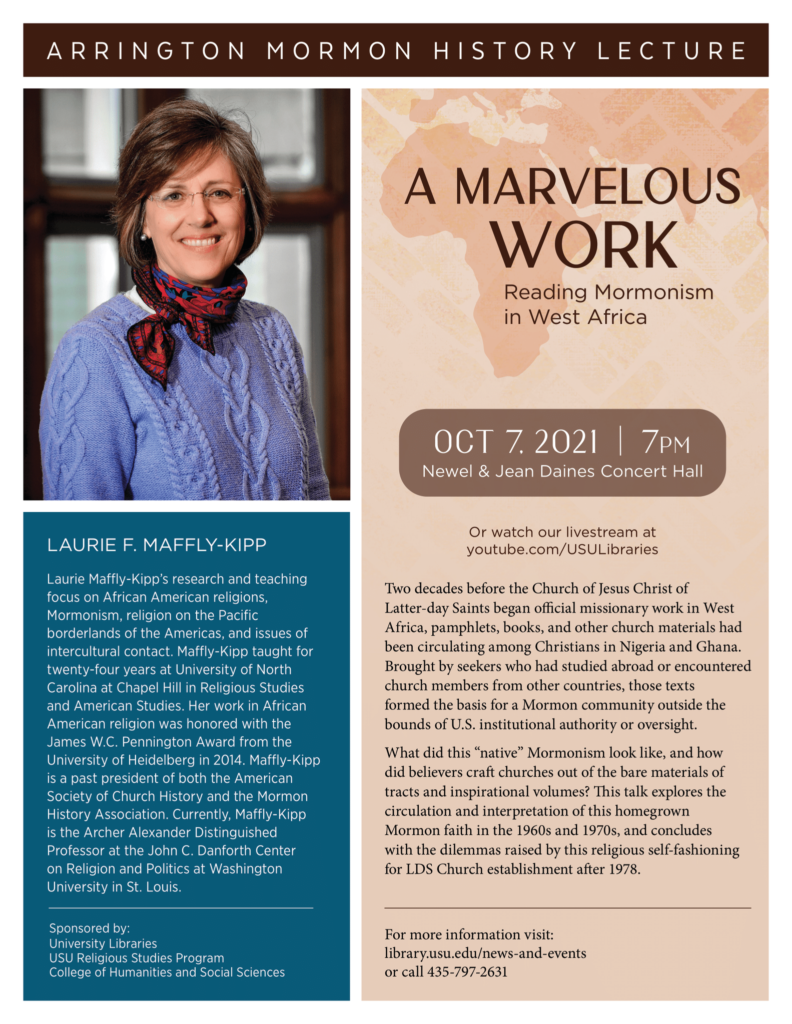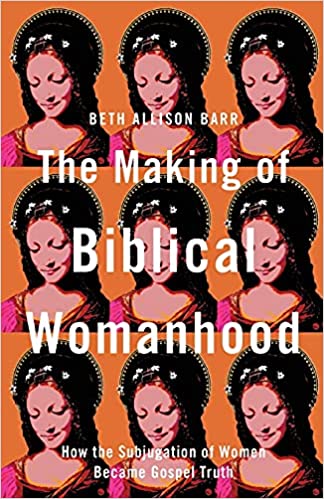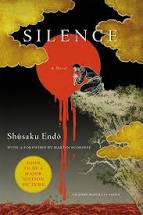Arrington Lecture: Laurie Maffly-Kipp: Reading Mormonism in West Africa
By September 9, 2021

By September 3, 2021
The John C. Danforth Center on Religion and Politics seeks applications from junior
scholars and recent Ph.D. graduates for up to four postdoctoral fellowships in residence at
Washington University in St. Louis. The appointment is for one year, renewable for a
second year. Eligible applicants must complete the Ph.D. by July 1, 2022, and are
expected to have completed it no earlier than January 1, 2017. In exceptional cases a
qualified applicant who completed the Ph.D. prior to 2017 or who hold a J.D. without a
Ph.D. may be considered. Research associates will spend most of their time pursuing
research and writing for their own projects. They will also serve the intellectual life of the
Danforth Center on Religion and Politics through participation in its biweekly
interdisciplinary seminar and events hosted by the Center. Their teaching responsibilities
will include: 1) developing one course per year to complement and contribute to the
Center’s curricular offerings, and 2) possibly assisting in one additional course each year
(depending on the particular teaching needs of the Center). Washington University in St.
Louis is an equal opportunity and affirmative action employer and especially encourages
members of underrepresented groups to apply.

By September 3, 2021
From friend-of-JI Brett Hendrickson
The Williams P. Clements Center for Southwest Studies at Southern Methodist University and the Eiteljorg Museum of American Indians and Western Art solicit papers that examine religion in the North American West. Selected participants will take part in a two-part symposium to workshop their papers leading to an edited volume. The symposium and resulting volume will examine the religious, spiritual, and secular histories of the Trans-Mississippi West, including western Canada, northern Mexico, and the trans-Pacific West such as Hawaii, the Philippines and American Samoa. The symposium will focus on the West(s) created by the contact of settler-colonists, migrants, and indigenous peoples from the 16th to 21st centuries. Paper topics should not merely be set in the North American West but should engage significantly with the region as a constitutive part of religious histories and experiences.
By August 3, 2021
Thanks to Dr. A. Griffin for this review!
On Pioneer Day this year, I sat in Florida, some 2,000 miles from my beloved Salt Lake City, feeling homesick. Nobody in Sarasota would even know what it meant if I wished them a happy 24th, let alone want to listen to me wax poetic about the cheese fries and dipping sauce at the Training Table (RIP) or hear out my opinions about what should or should not go in funeral potatoes. (Green onions, not regular onions. I will die on this hill.) Fortunately, I had an excellent companion for this bout of homesickness: This is the Plate: Utah Food Traditions, edited by Carol A. Edison, Eric A. Eliason, and Lynne S. McNeill, a sprawling volume that is particularly interested in parsing the fine-grained details of Utah’s cuisine. Readers can ponder the foodways of indigenous people, Greek immigrants, Mormon settlers, Salt Lake City’s Nikkei Senior Center luncheons, and many other groups.

By July 20, 2021
See a call for proposals on race and representation in Mormon Art. If you have questions, please contact Heather Belnap (BYU) and Nathan Reese (University of West Georgia).

By July 19, 2021
Thanks to Brooke LeFevre for this review!
It did not take long after I started reading The Making of Biblical Womanhood: How the Subjugation of Women Became Gospel Truth for me to be completely hooked. Really, it was on page 6 in the Introduction. Barr told the story of what inspired her to write the book—her husband’s dismissal from his job as a youth pastor. Barr, a historian of medieval Christianity, had long recognized issues with the idea of Biblical womanhood as it was taught in her Southern Baptist faith, but she had stayed silent for a myriad of reasons. Finally, she could not stay silent anymore. Barr wrote, “By staying silent, I had become part of the problem. Instead of making a difference, I had become complicit in a system that used the name of Jesus to oppress and harm women.”[1]

For me, those sentences spoke to an internal wrestle I was already having. You see, I had been thinking a lot about Eliza R. Snow. Eliza is, I think, a fascinating case study for the negotiations of patriarchy within nineteenth-century Mormonism.[2] Snow was not what we would consider a feminist. She did not believe in equality between men and women. She upheld the authority of men in the church over women and she taught that wives should submit to their husbands. However, she had a powerful voice within the church and used her voice to help dismantle or counter some patriarchal teachings and encourage women to obtain educations, pursue careers, contribute to the economy, and other things that we might look back on and praise for their feminist underpinnings. Eliza made a real difference in the church. But at what cost? Eliza, it seems, had to uphold the authority and superiority of male power within the church to be given space for her voice to be heard. She was, to some degree, complicit in a system that oppressed women.[3]
I had been wondering if that was still true today. Do women in the LDS Church today still have to support patriarchal systems to have a voice? Is the possibility of having a powerful enough voice to enact real change worth the risk of complicity in an oppressive system? I still do not have answers to those questions. But Barr’s book inspired me to think more critically about ideas surrounding womanhood within Christianity.
By July 15, 2021
Thanks to Stephen Betts for this stimulating post!
“The inability to conceive of its own devastation will tend to be the blind spot of any culture.”
—Jonathan Lear[1]
Chief Plenty Coups: Visions at the “End of History”
In the late 1920s, only a few years before his death, the great Crow chief Plenty Coups related his life’s history to his friend, the white ethnographer Frank Bird Linderman, who recorded that,
Plenty Coups refused to speak of his life after the passing of the buffalo, so that his story seems to have been broken off, leaving many years unaccounted for. ‘I have not told you half of what happened when I was young,’ he said, when urged to go on. ‘I can think back and tell you much more of war and horse-stealing. But when the buffalo went away the hearts of my people fell to the ground, and they could not lift them up again. After this nothing happened.’[2]
By July 9, 2021

Reading Endo’s Silence, recently made into a movie by Martin Scorsese, I was stuck by a mention of a Mormon theological concept. The story takes place in early seventeenth-century Japan, so it doesn’t mention Mormons specifically, but does mention a Mormon idea when discussing the theology of the Japanese Christians.
Silence focusses on Jesuit priests Rodrigues and Garrpe sailing to Japan after having heard that their mentor and hero, father Ferreira, had apostatized under torture. Silence is based on the history the harsh measures the Japanese government took toward crushing Japanese Christianity after the Shimabara Rebellion of 1638, driving Christianity there underground. Endo based the characters of Rodrigues and Ferreira on the actual Jesuit priests, Chiara and Ferreira, who did apostatize during the persecution. Endo himself came out of the Japanese Catholic community who saw the Japanese “Hidden Christians” as heroes and the apostate priests and not truly committed. Endo thus novelizes these Jesuits’ stories.
The Mormon theology comes in the buildup to the climax of the story after the Japanese capture Rodrigues and bring him to Ferreira so that Ferreira can convince Rodrigues to apostatize. Ferreira first begins by explaining the tortures he’s undergone before moving to his central arguments: “The one thing I know is that our religion does not take root in this country” (157). Rodrigues protests that the plant has been torn up and that Christianity flourished in Japan before the crackdown.
By July 5, 2021
The New-York Historical Society invites candidates with a humanities MA or PhD to apply for the position of Public Humanities Fellow in connection with the traveling exhibit Acts of Faith: Religion and the American West, which opens at the New-York Historical Society in New York City in November 2022.
We are looking for candidates with significant expertise in 19th century religion, particularly as it relates to Native American religion and spirituality. Applicants must have graduated from a humanities MA or PhD program (including public history and museum studies) within the last five years, and have a desire to practice publicly engaged scholarship. This is a two-year, full-time position, with the anticipated dates of Sept. 2021 through Aug. 2023, and the possibility of remote work during the first year. The position comes with a National Endowment for the Humanities stipend of $50,000 per year plus benefits. Some travel may be required.Applications will be considered on a rolling basis until the position is filled. For more information and to apply for the fellowship, click here.

By July 1, 2021
To commemorate the upcoming completion of the Revelations and Translations series, which includes the breadth of Joseph Smith’s revelation and translation projects, the Joseph Smith Papers Project will host the fifth annual Joseph Smith Papers Conference on September 10, 2021. The conference will be broadcast digitally to allow for both local and global participation from presenters and audience members. (This was also the format of the 2020 conference.) The theme for this year’s conference is “Joseph Smith and Sacred Text in Nineteenth-Century America.”
This event is free to attend, but space is limited. Please register only if you plan to attend; your courtesy will help us keep this conference series free.
Find the program and registration links here: https://www.josephsmithpapers.org/articles/2021-joseph-smith-papers-conference-registration.
© 2025 – Juvenile Instructor
Recent Comments
Steve Fleming on BH Roberts on Plato: “Interesting, Jack. But just to reiterate, I think JS saw the SUPPRESSION of Platonic ideas as creating the loss of truth and not the addition.…”
Jack on BH Roberts on Plato: “Thanks for your insights--you've really got me thinking. I can't get away from the notion that the formation of the Great and Abominable church was an…”
Steve Fleming on BH Roberts on Plato: “In the intro to DC 76 in JS's 1838 history, JS said, "From sundry revelations which had been received, it was apparent that many important…”
Jack on BH Roberts on Plato: “"I’ve argued that God’s corporality isn’t that clear in the NT, so it seems to me that asserting that claims of God’s immateriality happened AFTER…”
Steve Fleming on Study and Faith, 5:: “The burden of proof is on the claim of there BEING Nephites. From a scholarly point of view, the burden of proof is on the…”
Eric on Study and Faith, 5:: “But that's not what I was saying about the nature of evidence of an unknown civilization. I am talking about linguistics, not ruins. …”